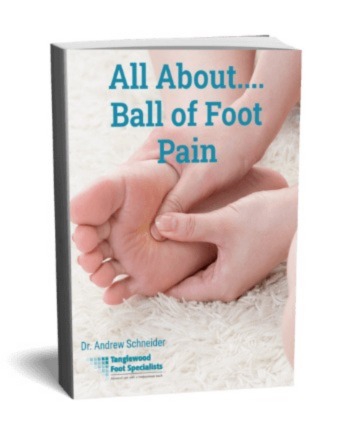Do you feel like you’re walking on pebbles? Maybe it feels like there’s a marble in your shoe and you can’t shake it out. If you’re experiencing pain in the ball of your foot that just won’t go away, you’re not alone. In fact, several conditions could cause these sensations. But, in this post, we discuss metatarsalgia, a possible cause of pain in the ball of the foot. We’ll explain why it develops and what you can do to feel better and walk comfortably once again.
Metatarsalgia: The Real Reason for Your Ball of Foot Pain ![A woman holding her ball of foot in pain]()
Let’s start by understanding exactly what is happening in your foot. The ball of your foot is an area just behind your toes where your metatarsal bones meet your toe bones. It’s a region designed to help you push off when you walk. But, when something goes wrong, every step can become painful.
Think of your foot like a tripod, with weight distributed between your heel and your and the ball of your foot. When this delicate balance is disrupted, certain areas take more pressure than they should. This extra pressure leads to inflammation, and that’s when the pain begins.
Now, here’s something that might surprise you: metatarsalgia isn’t actually a diagnosis. It’s more of a description of your symptoms. The real key here is to find out what’s causing your pain. In our Houston podiatry practice, we see several common causes of ball of foot pain. And understanding which one is behind your metatarsalgia is crucial for proper treatment. Let’s take a closer look at two of the more common causes of metatarsalgia.
Morton’s Neuroma
This is one of the most common causes of ball of foot pain. Imagine a nerve in your foot getting pinched and irritated and eventually forming a painful enlargement--that’s a Morton's neuroma. Patients often say that it feels like they’re walking on a pebble; they also might experience a numbness or tingling in their toes in addition to ball of foot pain.
Capsulitis
Another common cause of metatarsalgia is capsulitis, when the joint capsule in your ball of foot becomes inflamed. It often affects the second toe joint. If left untreated, it can lead to a condition where the toes start to drift toward your big toe.
Why These Painful Conditions Develop
Several factors can contribute to ball of foot pain. High-impact activities like running or dancing; wearing shoes with poor support or high heels; foot structure issues like high arches or bunions; being overweight, which puts extra pressure on the balls of your feet; or even tight calf muscles can increase pressure in this area. Luckily, if we identify the cause of your metatarsalgia, we can usually provide relief with non-surgical treatment.
3 Steps to Treating Metatarsalgia
First, we need to reduce the pressure on the painful area. This often starts with proper footwear. You need shoes with adequate cushioning and support to act as shock absorbers for your feet. The right shoe can make a dramatic difference to your comfort level.
Custom orthotics can also be a game change if you’re experiencing ball of foot pain. Unlike generic insoles that you find at the drug store, custom orthotics are precisely calibrated to your foot structure and condition. They work by redistributing pressure away from painful areas while providing the exact support your foot needs. If Morton’s neuroma is causing your metatarsalgia, we might use specialized padding to spread the metatarsal bones and relieve pressure on the nerve. On the other hand, if capsulitis is causing ball of foot pain, we focus on stabilizing the joint and preventing further deterioration. Clearly, knowing the cause of your pain is critical to finding effective relief. Sometimes, we’ll use advanced treatments like Shockwave Therapy which can be remarkably effective at reducing inflammation and promoting healing.
Home Care to Prevent and Relieve Metatarsalgia
In addition to in-office care, simple exercises can make a bog difference when it comes to relieving ball of foot pain. Stretching your calf muscles can reduce pressure on the ball of your foot. Rolling your foot on a frozen water bottle can help reduce inflammation and provide pain relief. Here’s a simple test you can do at home to see if you need to be addressing metatarsalgia. Try to raise your big toe while keeping your other toes down. If you can’t do this easily, it might indicate that we need to work on your foot’s flexibility and strength to prevent further problems.
Prognosis
Most patients start feeling better withing a few weeks of receiving proper treatment for ball of foot pain. However, complete resolution of metatarsalgia can take two to three months, depending on how long you’ve had the condition and its severity. The key is consistency with treatment and making necessary lifestyle modifications. And long-term success involves addressing both the symptoms and the underlying causes.
When to See a Podiatrist for Ball of Foot Pain
You should always make an appointment when you notice lingering pain anywhere in your toes, feet or ankles. But you should seek immediate care if you experience severe pain that comes on suddenly; swelling that doesn’t improve with rest; numbness or tingling that’s getting worse; pain that’s preventing normal daily activities; and bruising around the painful area. Remember, the sooner you address ball of foot pain, the easier it is to treat. Don’t wait for metatarsalgia to become severe. If you’re experiencing any of these symptoms, it’s time to get your feet checked out. You can request an appointment with Houston podiatrist Dr. Andrew Schneider by calling 713-785-7881 or by following this link to request an appointment.















